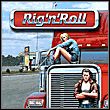Rig'n'Roll: Hints - managing your firm
Branch offices management
The main objective of this game (besides untangling the storyline's mystery) is to transform our spedition company called Nick Trucking into a potentate on the market of transporting services. Your character isn't able to fulfill this task alone, so you should very quickly try to expand your business by purchasing the licenses for cargo delivery in other Californian cities, by founding branch offices in these towns, by hiring additional drivers and expanding your machine park.
To achieve Golden Career status, you will need to sign contracts with all CCWA (California Commercial Warehouse Alliance) warehouses. This title, along with a big monetary prize, is rewarded to the company which is the first to sign contracts with all of the CCWA warehouses (in other words, be the first to reach 100 percent coverage). If several companies achieve 100 % coverage at the same time, the prize is awarded to the one with the highest turnover. If by chance the turnovers of these companies are also the same, the winner is considered the one with the fewest number of drivers.
Nick Armstrong (Pieriepielov in Russian ver. of a game) manages his firm from his main office located in Oxnard (initially Nick has only this one bureau), where he has got his supercomputer. Let's take a look at some more important screens displayed by this PC now, since many of you have problems with understanding what is written on them (when using copies of Russian version of the game).
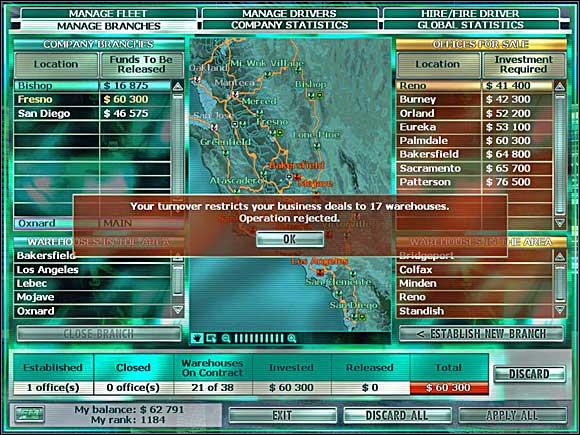
Let's try to decipher a thing or two, starting from branch offices management screen. It is the right place to buy cargo spedition licenses, which you should possess, to be able to take delivery orders from other Californian towns displayed on the map in the middle of the screen. You can deliver cargos to, and haul cargos among towns around Oxnard marked with green color on this map, because you've already got in them your branches (warehouses). So a green color means that Nick and his associates will be able to take order and cargo from such a warehouse, when visiting it.
White marked towns represent these ones where Nick and his associates can only deliver cargo to, but won't be able to take any orders from their warehouses. To do this you have to first found a branch office in this particular region of the state. Such a branch will serve several adjacent towns and then they'll also change their colour on map, from white to green. How to found a branch office? To do this check your chosen city on the list of towns close to the right edge of the screen, then press wide button under the list, and finally push the button in the lower right corner of the screen. After this the whole metropolis with its "slavish" towns will be transferred onto the list close to the left edge of the screen (the list of founded branch offices). Sounds simple, but you will notice, that this doesn't work always - we're clicking and clicking, but we can't found this branch office. Where's the catch? Well, to expand your company with branches you have to fulfill some additional terms. First - you must have enough cash destined for purchasing a given license (the required sums are written on the list next to city names). Second and most important: your firm should generate meaningful turnover (the total daily income the company makes on the warehouses' orders). You can check your present revenues on two other statistics screens generated by Nick's supercomputer.
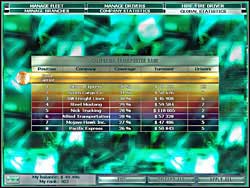 Global statistics.
| As for turnovers: it's hard to determine what are the exact numbers that interest game. Thought you can valuate this more or less by taking a look at global statistics screen and examining what are the turnovers of other companies, which have the coverage you're currently interested in. It is a safe bet thought, that if you don't want to stay behind your competing companies, then you should work on your firm's profitability right after starting the game. Work on this by hiring some additional drivers, buying trucks for them and managing their jobs. Purchasing licenses for cargo delivering to other Californian warehouses is not so important for the moment. |
At the beginning Nick has 150k $ of cash - it should be enough to hire at least 2 drivers and purchase 2 cheapest trucks for them.
If you drive around California for fun mostly, but you care about the development of your business too, then you have to spend practically all of your money on hiring new drivers and purchasing trucks for them. Initially you'll do this for a long time and at the expense of resigning from upgrading your own truck, because this game is quite demanding in its economic aspects.
Though dodgers who want to go quick and dirty may use a little trick to quickly obtain this desirable Gold Career status. Do you remember still that for that title you must purchase all the licenses first, and your firm should generate respectively high daily income? So you can spend the whole day in game doing warehouses' orders (only them!), helping your employees, and then go before 6 p.m. to one of your offices and purchase another license. You should have sufficient revenues for this. Repeat the whole procedure in the next days to quickly obtain all the required licenses and to win the title.
The hiring of drivers

You can hire and fire your drivers on the next screen displayed by a supercomputer in the base. In order to do this you have to click two buttons located between the list of available drivers (on the right) and the list of hired ones (to the left). Every operation of this kind you should confirm by pressing the button in the lower right corner of the screen (button next to it, to the left, means "discard all" and another stands for "exit"). You will surely notice that you don't have an access to all drivers at once - names of these who can be hired are written white on the list to the right. Other drivers will become available once you have sufficient rank. Naturally, all drivers have their attributes: according to them, you can decide which drivers will be displayed on the list - just click these small arrows located to the right. That's all, as for the translation of what's on the screen and where, for owners of Russian ver. of a game. You will find more about drivers and their attributes in the next chapter of this guide, called "Administrating the work of the drivers".
Truck purchasing
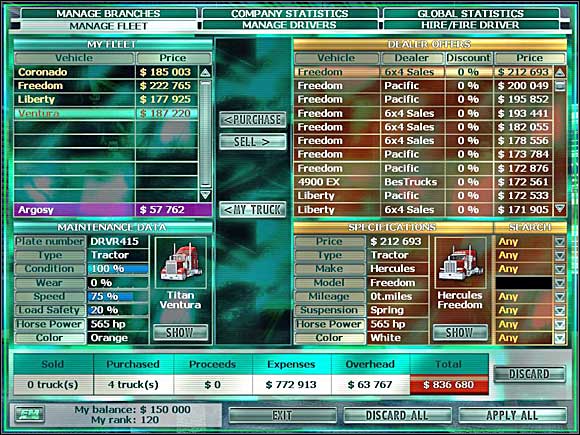
After hiring a driver it's time to purchase a tool for him. I mean - the truck ("semitrailer towing vehicle", if using professional vocabulary). You can do this in next window. You may sort vehicles on the list to the right, according to their prices, for example, by hitting buttons located on top of this list. You can also do a search - buttons close to the right edge of the screen let you decide which vehicles will be displayed on the list (according to what parameters). List to the left shows your already purchased trucks of course. You can buy and sell vehicles by pressing two buttons located between both lists. Button under them allows you to select your truck from these already purchased - you'll use this truck in game. I recommend using the default truck (you have it from the beginning), since it's one of the best trucks in game already.
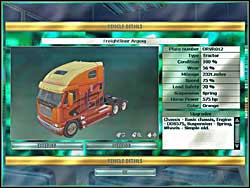 Truck technical data.
| Under the trucks' thumbnails you can find buttons that allow you to take a closer look at these vehicles - you can see them from the external view or in-cab view. There will be also some technical data presented to you. Condition, wear and mileage of the truck determine how often this vehicle will probably need to be repaired. It goes without saying: the worse condition and greater wear and mileage, the bigger need for repairs and frequency of visiting mechanic in the future. Dynamics, which means speed of the truck (though displayed not in mphs, but in percents), shows the vehicle's racing capabilities. The bigger this attribute is, the greater the chances that this vehicle will win in races. |
Load Safety or Ride Comfort indicates the truck's fitness for transporting fragile cargo. When this value is small you should avoid transporting such a type of cargo with this truck, because it will be easier to damage your load in even a minor accident. Next parameter stands for suspension of the truck: soft suspensions are good for delivering fragile cargos, but they don't work as good in races without trailers. Hard suspensions - vice versa. Other attributes you can examine are: truck's engine horsepower, color of the vehicle and already installed components.
When you know already to what attributes you should pay attention, according to tasks these trucks will be purposed for, then it's easy also to match proper vehicle with a specific type of driver (sprinter or trailer hauling admirer). Your drivers will take care about their vehicles by themselves, repairing these trucks when they need to, but you must upgrade their vehicles by yourself, according to what these cars are purposed for. In order to do this you have to visit one of your offices and set such a vehicle as yours. Then go to the neighboring repair shops, choose and install necessary parts. After this return to the office and bring back already upgraded truck to his driver.
All operations on trucks (buying and selling them) you have to confirm by pressing the button in the lower right corner of the screen.
Notice also, that truck dealers give discounts to loyal customers, so try working with the same seller. Truck manufacturers also give discounts to loyal customers, so purchasing vehicles of the same manufacturer can net you some savings.
Keep in mind, that, when buying trucks, you'll have to pay any additional charges, such as dealer's commission and delivery fees.
Administrating the work of the drivers
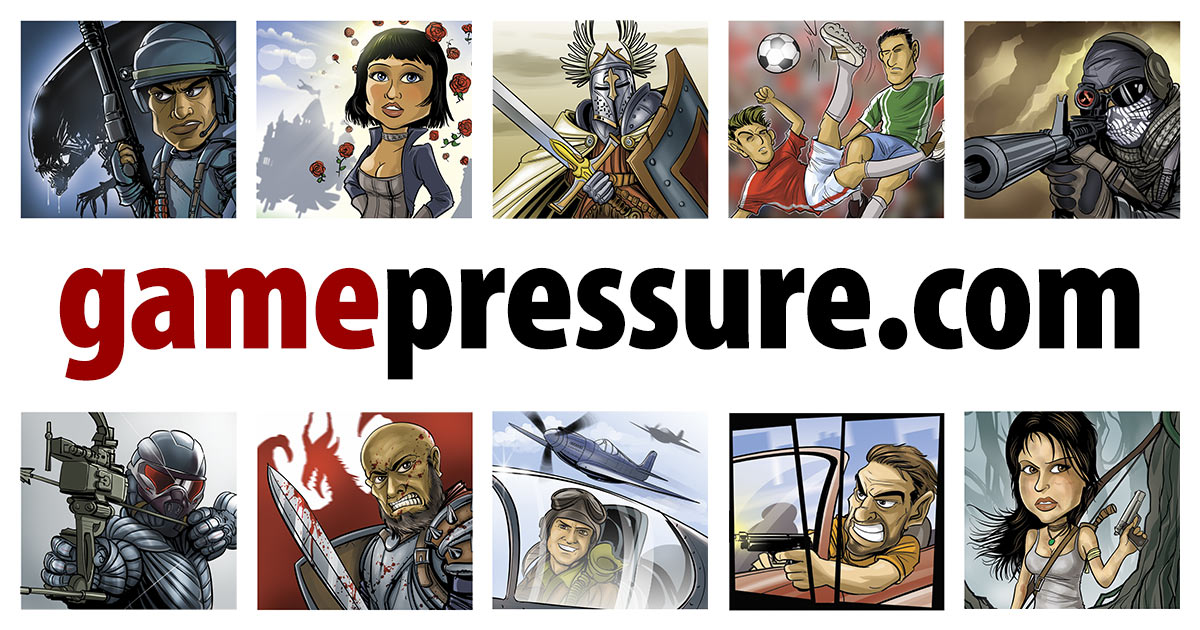
When you've finally purchased several drivers and bought trucks for them (at first I suggest to choose the cheapest ones, though with engines as strong as possible), it's time for administrating the work of your personnel. The next screen displayed by Nick's supercomputer is dedicated for this purpose. By clicking driver's name on the list to the left, and then moving sliders in the first window atop on the right, you can determine the nature of orders this driver will handle. Thus: types of orders (races or cargo deliveries) he should prefer in his work (first slider atop), susceptibility to breakages of cargos selected by him (vulnerable/not vulnerable) and trip distance (short distances on the left and long on the right edge of 3rd slider). As for cargo types, which our drivers should handle with in the beginning, I'd suggest leaving the slider in its default position. Unless our purchased trucks have strong engines installed - then you can shift this slider to the right. You can also choose favored orders according to the percentage of victories presented by a particular driver (see below). In this case the more wins on driver's account, the higher probability that he prefers races without trailers, instead of cargo deliveries. Leave these fragile cargos for experienced and more careful truckers, the rest of them should focus on deliveries of less fragile loads or races without trailers.
When choosing type of cargo, which your driver should prefer in his work (fragile or not fragile), it is worth to pay attention to maintenance costs of a truck he uses, that he pays daily during his work (see below). Carefully driving employee spends less money on truck repairs, thus you can give him orders concerning deliveries of fragile cargos. When it comes to trip distances I propose to take initially only these shortest - move the slider all the way to the left. You should remember, that on longer route your driver may be penalized with tickets on tidy sum of money, he may damage his truck heavily (repairs will also cost us a lot), and finally he may lose the competition (race) against his opponents. And arriving at the warehouse on the last place with damaged cargo equals deducting some money from max fee you'd earn for this delivery. Finally, you should take into account that after arriving at the warehouse located in the area, where you don't have your office, your driver will only leave his cargo, but he won't be able to take another. So he comes back with empty hands - it's a waste of time and money (in the same time he'd do several shorter deliveries). Summa summarum, in the beginning of a gameplay short trips among the cities located within the "operational range" of one of your branches are more lucrative and less risky. Though if you still insist to make long trips with trailers, then I'd suggest giving them to careful drivers, who don't have too many tickets on their accounts. Give short orders to your most aggressive drivers, causing many car accidents and paying a lot of forfeits daily (see below). Shortly - match trip distance according to the amount of driver's forfeits.
Three sliders in the middle window let you decide, what the computer should take into account, while selecting trucks (you've bought) for your drivers. Unfortunately you can't do this (choose vehicles) by yourself. First slider represents the wear of the vehicle - the greater wear, the bigger need for repairs in the future and you'll have to spend more money on refits. Thus driver which uses this vehicle will generate respectively smaller income (depleted for costs of repairs), so I'd recommend giving these worn vehicles to your best employees, often winning the orders, in order to minimize your losses. 2nd slider represents speed of vehicles chosen by the computer for your drivers. For races without trailers choose fast trucks, for deliveries of cargo - slowest vehicles. 3rd slider represents "cargo safety" (or "ride comfort" in other words) and by shifting it you can choose type/quality of suspension of the vehicle. Soft suspensions guarantee good safety for hauled cargos, so this type of suspensions is good for cargo deliveries, especially fragile, damageable loads, but perform badly in races without trailers.
Slider on the bottom allows you to specify daily wage of your selected employee. This has direct impact on driver's loyalty towards your firm, and on turnover generated by this company, of course. High wages raise a driver's loyalty but decrease company profit. If a driver's profitability increases, but his wage stays the same, his loyalty will decrease, since effective drivers demand to be paid more. If an employee's loyalty reaches 0 (zero), he quits the company the next day. Similarly, if a driver doesn't receive his wage for 2 days in a row, he also quits the company. In such cases the Freight Manager (FA - Nick's supercomputer) will warn you suitably earlier. Wages are paid in advance for the next day of work, and they're paid every day at 6 p.m.
Naturally you can leave all of this to Nick's supercomputer (FA), by checking the squares located under each window with sliders. It's the safest solution, that guarantees some small but constants profits and zero losses to your firm, though the automatic mode is the least effective, because when you use it, you do not fine-tune your truckers' activity, so they cannot do their best.
Confirm all operations executed on your truckers by pressing the button in the lower right corner of the screen. On the map in the middle of the screen you can see where your driver is currently.
To the left, under the list of hired truckers, the game presents to you some data related to the productivity of your employees. You can see there the level of loyalty, the daily income generated by a particular driver, and the index in percentage of his wins in orders he undertook. As for loyalty - it doesn't depend on employee's wage only. For example, you may be taking a driver who likes to drive fast and forcing that driver to transport fragile cargos, or telling a careful but slow trucker to take part in races - in consequence the loyalty of both employees will decrease, because they'll feel unhappy with their tasks. Below wins percentage is displayed the daily amount of driver's forfeits - these penalties can be sizeable in case of giving incorrectly assigned orders (to inappropriate employees). Next there are daily costs of the maintenance of the vehicle used by this trucker - these are sums he spends on repairs. High costs of maintenance may be the consequence of incautious driver who is incorrectly assigned to this particular truck, or may be the result of a serious wear of the truck. Gas is the amount of money your company spends daily to pay for fuel - fuel expenses can be high for powerful or worn vehicles.
- Rig'n'Roll Game Guide
- Rig'n'Roll: Game Guide
- Rig'n'Roll: Game Guide - Default key bindings
- Rig'n'Roll: Hints - managing your firm
- Rig'n'Roll: Hints - on the road
- Rig'n'Roll: Truck tuning
- Rig'n'Roll: List of Trucks
- Rig'n'Roll: List of Drivers
- Rig'n'Roll: Storyline solution - Part 1
- Rig'n'Roll: Storyline solution - Part 2
- Rig'n'Roll: Map of California
- Rig'n'Roll: Game Guide
You are not permitted to copy any image, text or info from this page. This site is not associated with and/or endorsed by the developers and the publishers. All logos and images are copyrighted by their respective owners.
Copyright © 2000 - 2025 Webedia Polska SA for gamepressure.com, unofficial game guides, walkthroughs, secrets, game tips, maps & strategies for top games.
